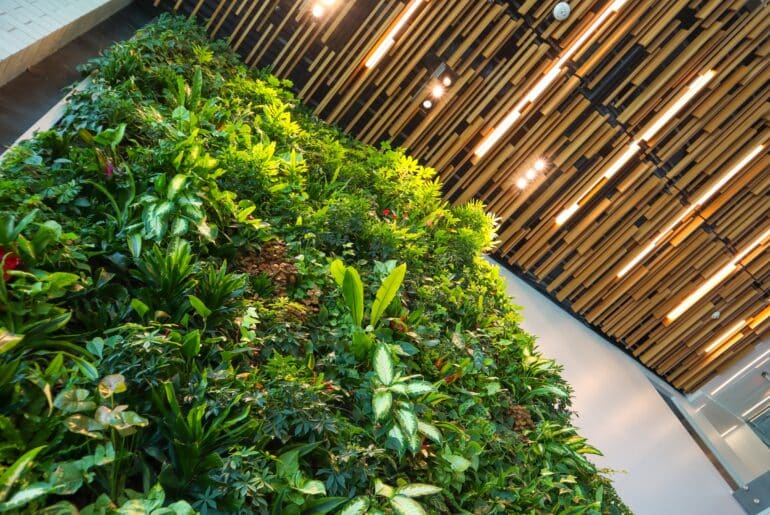In 2018, more than 90% of CEOs agreed that sustainability is key to the success of their company. This may partially stem from the finding that a staggering 86% of Americans expect companies to take action on social and environmental issues.
A growing number of firms use Sustainability Programming to address increasing demand for responsible practices. These programs vary from company to company, reflecting niche needs, values, and priorities, but they reflect a common goal: Planning to meet the present needs of society without compromising the needs of future generations. Sustainability programs create collaborative, values-driven frameworks for social and environmental impact, and customers take notice.
BUT WHERE DO BUILDINGS FIT IN?
While Sustainability Directors often manage these programs, any role from Directors of Construction to Creative Directors and Community Outreach Managers can get involved. Dedicated sub-committees often form to manage specific strategies and goals. One of the most common and impactful focus areas lies in real estate strategy: How does your building portfolio reflect your sustainability goals?
This question carries increasing importance as companies grow, as investors and tenants alike demand that properties incorporate environmental and social governance. It is up to a company’s Sustainable Real Estate (RE) Program to respond, and Stok’s latest research on what key factors lead to their successful design, implementation, and management will provide companies with clear priorities on how to do so.
SUSTAINABLE RE PROGRAMS: INTERNAL DRIVERS
Sustainable RE Programs typically involve company-wide high-performance standards and policies related to purchasing, designing, retrofitting, and/or occupying buildings. Firms use Sustainable RE Programs to manage their real estate portfolios in a way that supports company values, employee health, broader community efforts, and corporate responsibility goals. The diverse benefits of Sustainable RE Programs include:
Savings on utility and maintenance costs. Innovative technologies have created competitive markets for energy and water conservation, consequently reducing utility bills and reliance on fossil fuels. 85% of Stok’s survey respondents listed this as the top reason for implementing a Sustainable RE Program.
Branding. A company’s spaces serve as an extension of its brand, providing visitors and occupants with a physical expression of brand values. 45% of Stok’s survey respondents listed improved branding as a first- or second-ranked motivation.
Climate change action. The built environment is responsible for a third of global energy consumption.
Workplace transformation. The design of our built environment radically impacts our productivity and health, especially when you consider that 35% of the average employee’s waking hours are spent at work.
Human health. High-performance buildings are proven to enhance the cognitive functioning of its occupants, contributing to increased productivity, higher retention rates, and fewer sick days.
Employee performance. Collectively, financial savings from high-performance buildings can return an average of $23,584 per employee and $129 per square foot over ten years, assuming a $20 per square foot cost premium.
Community benefits. Investments in healthy, efficient buildings prove to be the greatest opportunity for companies to reduce carbon emissions and support local sustainable development.
SUSTAINABLE RE PROGRAMS: EXTERNAL DRIVERS
The impacts of a responsible real estate portfolio go far beyond company-wide benefits. Local and global climate change initiatives continue to evolve in response to foreboding climate reports. Over 400 U.S. mayors have joined the Climate Mayors network, indicating dedication to leadership on climate change in their communities. Local goals and strategies vary significantly, but buildings present a universal opportunity for intervention and redesign, given that they account for 28% of global carbon emissions.
The evolving conversation around climate change presents emerging opportunities for innovation. In Denver, CO for example, the city’s Climate Action Plan calls for a 50% reduction in commercial building energy use by 2050, and all new construction will be Net Zero Energy by 2035. Denver also ranks ninth nationally in percentage of all buildings that are LEED certified.
Though these policies and trends may appear daunting at first, companies are presented with incredible opportunity to innovate. Novel strategies in energy reduction can attract local and national praise and offer new value to an unlikely brand. This new age of climate-related requirements presents a challenge to all companies, and collaboration is needed to achieve global goals.
SO, WHAT MAKES A SUCCESSFUL SUSTAINABLE RE PROGRAM?
Though sustainable real estate is a common interest across industries ranging from Starbucks to Salesforce, many companies lack an effective, strategic portfolio-wide program. Whether your organization is starting to think about outlining a Sustainable RE Program or knee-deep in implementation, each phase of the program development presents its own unique challenges.
To facilitate a collaborative effort and share best practices, Stok interviewed 17 major companies about their Sustainable RE Programs. Our respondents manage over 28,000 office, retail, manufacturing, hotel, and distribution spaces in the U.S. and internationally. The findings and key takeaways are distilled in a Stok handbook set to be available to the public in late 2019. The purpose of our handbook is simple: What major factors should companies consider in order to achieve greater social, environmental, and financial benefits through their real estate? How can we enhance the design, implementation, and tracking phases of these Sustainable RE Programs?
The insightful results will provide immense guidance to companies looking to capture value and positive impact from their building portfolio. Stay tuned to hear more about Sustainable RE Program innovations. In the meantime, reach out to discuss how your organization can design, retrofit, or manage your company’s high-performance buildings.




